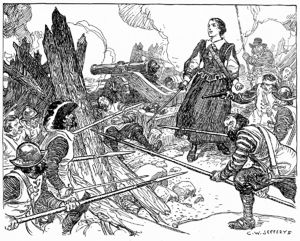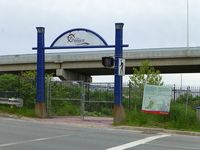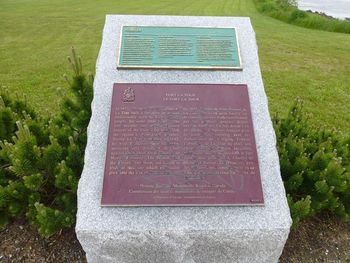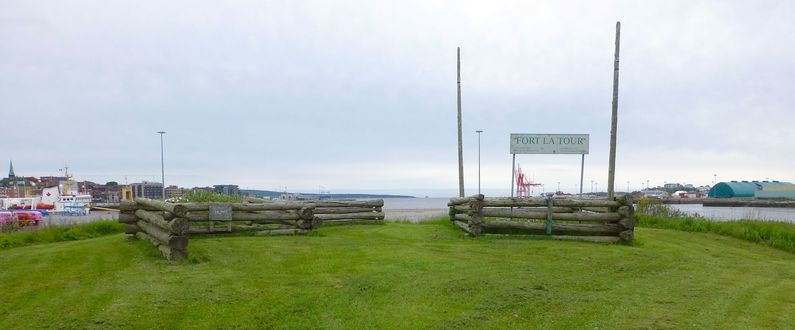Fort La Tour
|
Fort La Tour (1631-1654) - A French colonial fur trading post established in 1631 by Charles La Tour, in present day Saint John, Saint John County, New Brunswick, Canada. Attacked and rebuilt five times and finally abandoned in 1654. Also known as Fort Sainte-Marie.
History of Fort La TourA small fortified French trading post located on Portland Point by Charles de Saint-Étienne de La Tour. The original post contained only two or three wooden buildings surrounded by a palisade with two bastions on the water side. The post was enlarged in 1639 to a 120' square palisaded and moated compound with a large gatehouse on the western side. Inside the compound, there was a large trading house on the northern side and a stone bastion in the southwest corner with one six-pounder gun covering the harbor. A bakery, blacksmith shop, chapel, and storerooms made up the eastern and southern sides of the palisade. Acadian Civil War (1635–1654)La Tour had been granted a governorship over a portion of Acadia which unfortunately overlapped a portion of Acadia that had been granted to Charles de Menou d'Aulnay. The resulting conflict between the two men became known as the Acadian Civil War. Fort La Tour was La Tour's main base while Port Royal was d'Aulnay's base some 45 miles away, across the Bay of Fundy. New England supported La Tour's claim because he allowed them to fish and lumber in the area freely, d'Aulnay sought payment for that right. La Tour went to Boston to ask governor John Winthrop of Massachusetts for assistance. Governor Winthrop arranged for the purchase of men and material to defend Fort La Tour from an impending attack by d'Aulnay's forces.  In April 1645, while La Tour was still in Boston, Fort La Tour was besieged by Charles d'Aulnay's forces. La Tour's wife led its defense, but she was convinced to surrender when d'Aulnay promised to spare all the defenders. D'Aulnay reneged on the terms and hung all 47 defenders except one who agreed to act as executioner. Madame La Tour was forced to watch the executions with a rope around her own neck, she was spared but died three weeks later. D’Aulnay buried Madame La Tour at the fort with the other defenders and sent her young son back to France in the care of a servant. The fort was all but destroyed in the battle but it was rebuilt by d'Aulnay, strengthened and continued to operate profitably until d’Aulnay died. La Tour learned of his wife's death and the destruction of Fort Tour in late June. He then departed for Quebec to restore his fortune. In May 1650, d’Aulnay died of exposure when his canoe overturned. La Tour was soon bound for France, where he managed to restore his name and authority in Acadia. He also regained title to the fort in 1650, but it was not recovered until he returned in 1653. He married his rival’s widow and adopted her eight children, adding five more of his own. The fort was unsuccessfully attacked again in 1654 by rival French forces under Emmanuel le Borgne who was one of d'Aulnay's creditors.
The EnglishThe fort was again captured in July 1654 by the English under Major Robert Sedgewick. La Tour was captured and sent to England. The English took control of the area from 1654 to 1667, and apparently garrisoned Fort La Tour (Oliver Cromwell asked La Tour to pay the expense of the garrison as one condition for his release).
Current Status Fort La Tour Provincial Historic Site, Saint John, Saint John County, New Brunswick, Canada. This site is located along a harborside walking path known as Harbour Passage Trail below the north end of the Saint John Harbor Bridge. There are several trail access points and normally the easiest access is from Fort La Tour Drive. Construction on the Saint John Harbour Bridge has closed this access point and the Hilyard Street access point so it in necessary to use Long Wharf or Union St. access points. The site has just a couple of log fences like installations and a marker, no interpretative signs could be found so it is difficult to know what they represent. On the other side of the path are three statues that appear to be historic figures associated with the fort. Archaeological excavations of the site, off of Chelsey Drive, were done in 1955-56 and 1963.
See Also: Sources:
Links: Visited: 14 Jun 2013 |
||||||


